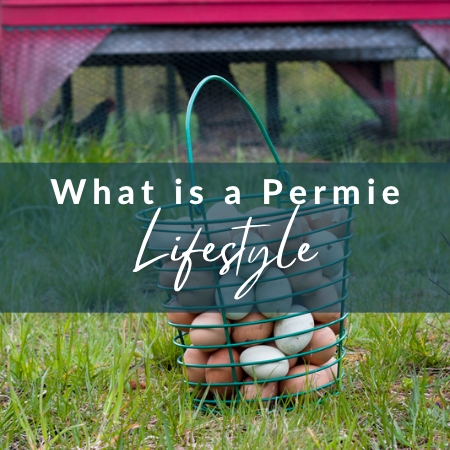What is a permaculture lifestyle?
People are familiar with growing food as a permaculture practice, but they may not realize there is a lot more to it!
A permaculture lifestyle embodies the application of the ethics and principles of permaculture within all aspects of a home, property, and family’s activities. Beyond the agricultural, farming, or gardening applications of permaculture, the ethics of Earth Care, People Care, and Fair Share and the 12 principles are applied to the household’s consumption of resources and utilities, management of waste products, and community interaction.
Here are eight ways you can ease yourself into the permaculture lifestyle:
1. Slow and phased approach.
If you jumped into this like jumping into a fad diet, chances are you might give up on it. Taking on too many changes at once can be overwhelming. Set realistic goals you know you can achieve. An example of this might be keeping a compost bucket in the kitchen to collect all of your veggie peels and scraps. Every few days you take it to a designated area outside for composting. This may be a worm farm, a heap, a tumbler, or a multi-bay system! When you start with small and focused goals, you can then start adding to it once you have your new routines established.
2. Grow your own food.
No matter what climate you live in, you can grow your own food. In tropical areas, you may need shade houses, whereas in cold climates you might want to invest in a greenhouse. Start small and slow (see point 1!). If space is limited, start with an indoor planter box that you keep in a sunny window. Peas, bush beans, Swiss chard, kale, lettuce, carrots, tomatoes, and radishes are really easy and very rewarding crops! You’ll learn pretty quickly what works and what doesn’t, and over time you can expand your garden! Growing your own food is healthier for you because its more nutrient-dense and toxin-free, and better for the environment.
Have you ever seen the Permaculture Egg vs Industrial Egg by Geoff Lawton? Check it out!
Permaculture Egg:
3. Reduce your waste.
Creating a ‘closed-loop’ system is easier than you might think. Once you start collecting all of your scraps and shredding your mail, composting it into soil, you start to see your rubbish bins aren’t full as quickly. You’ll also notice you’ve created really healthy soil which is easier on the purse come planting time! You may choose to reuse jam or peanut butter jars, to save seeds for the next years crop. Yoghurt containers can become seedling pots. Old furniture can be painted up and sold or turned into something new! Once you start viewing objects through the permaculture lens you start to realize the many different ways they can be reused or recycled.
4. Be energy efficient
Energy efficiency may be how you use energy, but its also how you catch and store it. By having energy efficient appliances, turning things off when you’re not using them, and using manual methods, you can be more resourceful with energy usage. For example, you might choose to hang your washing on a line outside rather than use a dryer! You also want to be energy efficient in your movements. By growing favorite crops near the kitchen, or keeping a chicken coop close to the house, you don’t have far to walk to collect eggs or veggies. Its important to be thoughtful in what energy resources you have available to you, and how you budget for them in space and time.
5. Collect Rainwater
Whether collecting in tanks or in the soil, water harvesting is an important part of living the permaculture lifestyle. Storing in tanks makes it readily available for personal use, or for irrigation (depending on the system you have set up, and the quality of water). Storing water in the soil can be done using swales, ponds, dams, or the keyline method. Storing water in the soil means you reduce the amount you use for irrigation, and the plants have better access making them more healthy and resilient. Both of these are usually implemented to some degree in a permaculture-designed landscape.
6. Create Diversity
This reminds me of the saying about not putting all of your eggs in one basket. When you diversify, you are more resilient. Diversity in plants means you still have a yield if one crop is damaged by pests. Diversity in your network means you have opportunities to offer and receive support. And diversity in employment may mean you sell a craft alongside your fresh honey or CSA basket. You don’t need to quit your day job to diversify your income! The 2019-2021 pandemic taught us all how vulnerable our ‘day job’ employment may be… when you diversify, you create a safety net you might need to rely on.
7. Create a Community
Join a community garden, or, start one! This may start as inviting a few friends over to your garden to help out with your garden while everyone learns from the experience. In large cities, it might be renting a plot in a community garden space and meeting regularly with other members to share ideas, skills, labor, and knowledge. It may be applying to your local town, municipality, or city to have access to unused land where the upkeep you and other members provide reduces costs for the maintenance of the plot and you get to use it with no capital cost or rent outlay. All of these are ways to get together with other people who are interested in gardening, permaculture, and earth care.
8. Learn the ethics, and principles and follow the gurus!
Designing a lifestyle around permaculture ethics is one of the more important things you should focus on. Once you understand earth care, people care, and fair share, you realize how much you’re investing in yourself, your community, and the environment. Follow people on YouTube; follow Geoff Lawton, David Holmgren, Milkwood, Morag Gamble, or Verge. You can learn a lot of tips and tricks, but you’ll also understand the differences in lifestyle and how you might be able to make small changes in your daily life. If you’re interested in just learning about how to grow vegetables, Charles Dowding has an excellent channel for learning basic through to advanced gardening methods using no-dig gardening.
Tackling this one step at a time. Transitioning to a different way of living can be challenging, especially if you want to do it all at once. Allow yourself some grace because these things take time and it’s not like setting ‘New Years’ resolutions’. If you do it like that, you’re setting yourself up for a harder time than it needs to be, and may even give up on it. Start small! Buy products that use less plastic, start with one small vegetable garden rather than a whole yard full, join a community garden or gardening club, collect rainwater, and start a compost pile. These are all small steps that you can take to create new habits which will save you time and money!



